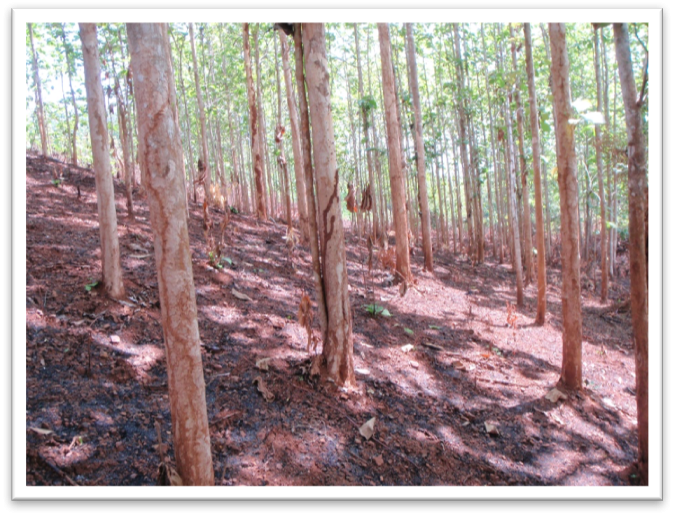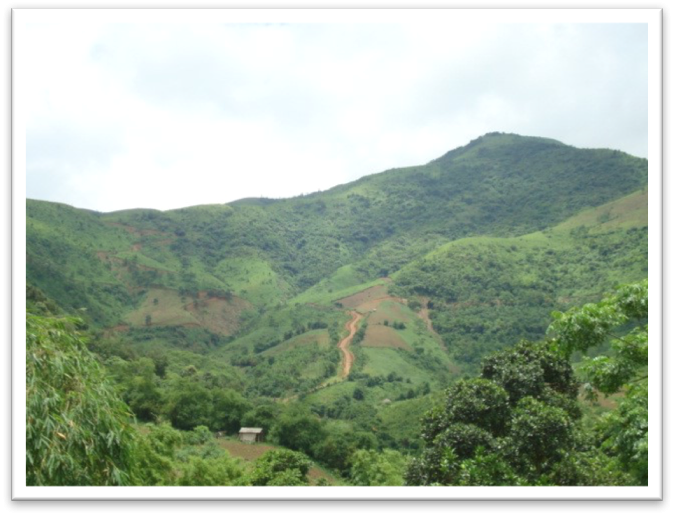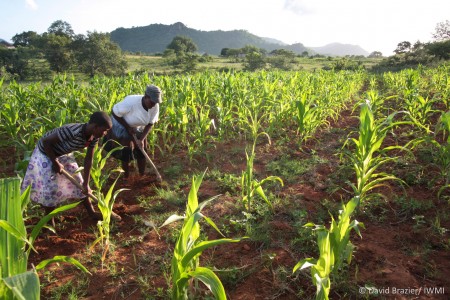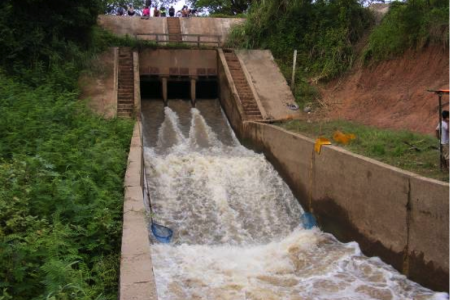A comparison of forest hydrology in Laos and Vietnam
It seems like a safe bet to say that planting trees is a good thing: who could argue with that? Well, not so fast. A group of researchers, after 15 years’ careful work, have finally confirmed that growing trees in a plantation—in this case, a teak plantation—actually increases water runoff, erosion, and downstream silting when compared to naturally regrowing forest areas.

According to the most recent Global Forest Resources Assessment, published by the UN’s Food and Agriculture Organization in 2015, more and more countries (13 at last count) are moving from losing forests to increasing their forested area. It is not too early to want to understand the impact of these changes.
Scientists from the CGIAR Research Program on Integrated Systems for the Humid Tropics and the French Institut de Recherche pour le Développement worked with colleagues from Lao PDR, and Vietnam to compare different land-use situations in two upland agricultural areas exposed to the same monsoonal climate. In the Houay Pano catchment of northern Laos they looked at what happened when local people gave up rice-based shifting cultivation and started cultivating teak trees in plantations. In the Dong Cao catchment of northeastern Vietnam, they looked at land that had gradually reverted to natural forest after being used for annual crops and fodder, or mixed-trees plantations.
In northern Laos, converting farm land to teak plantations increased the seasonal water flow in neighbouring streams; meanwhile, at the Vietnamese research site, moving from annual crop and mixed-tree plantations to naturally re-growing forest led to decreased water flow. This may appear counter-intuitive. It all came down to how the land was managed.
In Vietnam, the natural ground cover allowed rain to penetrate into the soil, which allowed plants to develop deeper and thicker root systems as well as a denser tree canopy. So the rainwater was better absorbed by the soil and then transpired by the growing trees (i.e. evapotranspiration), resulting in less water leaching into the streams during both the wet and the dry seasons, and an overall reduction of erosion.

In Laos, farmers moved from a shifting rainfed rice-based system to teak plantations. Teak trees usually develop a thick canopy and deep and dense root systems, which theoretically should reduce streamflow by increasing evapotranspiration. However, the hydrological effects of a teak plantation in Houay Pano were very different. The area beneath young teak trees is cultivated with annual crops inducing high rate of soil surface crusting; the large leaves of mature teak trees concentrate rainfall into big drops that hit the soil with increased kinetic energy, hence forming surface crusts; what’s more, most farmers intentionally keep the soil bare under mature teak trees by recurrent burning of the understorey. These three actions created a soil crust in the plantations that was four times less porous than fallow land, producing higher runoff and streamflow, and—crucially—intense erosion.
The distinguishing feature of this research is its scale and thoroughness. Previous research into this topic has looked at 1m2 micro plots; by contrast, this work confirms previous finding at a scale about 1 million times larger (i.e. 1 km2), which is more appropriate for water resource managers. The scientists mapped land-use changes over a 13-year period by conducting detailed field surveys, recording daily water data and using modelling and statistical tools to match water flow differences against land use changes while isolating the compounding effect of climate variability.
In the reforesting area in Vietnam, streamflow dropped 67 percent in the wet season and 84 percent in the dry season. In the teak plantations in Laos, streamflow increased 100 percent in the wet season and 650 percent in the dry season. Such major hydrological changes have tremendous implications for natural resource management policy, especially in Laos. The Government of Laos has set a goal to increase forest cover to 70% by the year 2020. One of the key drivers of this forest cover goal is the Government’s commitment to hydropower development: increasing forest cover will theoretically provide an increase in available water for hydropower in the long term.
Further implications for practice and policy
CGIAR’s research has demonstrated that such a conventional idea about the linkages between forest cover and hydropower development is not necessarily true. On the Vietnamese side, natural regrowth actually decreased the amount of water released into the catchment; on the Lao side—while streamflows did increase significantly—the high rate of erosion associated with teak plantations led to excessively sedimented water, unsuitable for hydropower development and detrimental to aquatic ecosystems.
According to Guillaume Lacombe, one of the authors of the paper that inspired this blog, these results are not necessarily typical of afforestation and should be used with caution. For instance, in Vietnam, the reduced streamflow that was observed during the dry season is not necessarily characteristic of all forested areas. In other situations, forest growth significantly improves the soil capacity to absorb and store water while the increase in evapotranspiration caused by the growing vegetation remains moderate. These two concurrent changes result into a net gain in groundwater recharge followed by an increase of streamflow during the dry season, while, at the same, total annual flow decreases. As such, it is important to consider the site-specific effects of the vegetation on the soil during both the wet and the dry seasons when attempting to link water resource management to land use.
In the example in Laos where soil erosion is the key issue, there is room for positive change in teak plantation practices, Lacombe said. Teak farmers could cultivate polyculture plantations rather than burning off ground cover in between their trees. If teak trees were interspersed with broom grass, for example, water could infiltrate the soil rather than causing erosion; furthermore, farmers could sell the broom grass and their derived products, thereby reaping an economic benefit from a hydrological solution. Depending on local soil and climate conditions, other perennial crops, like cardamom or galangal, can also bear positive hydrological and financial results. All these agroforestry species need to be implemented early on in the development of a plantation when its canopy is still sparse and allows the crop to grow normally.
Although important for the sustainable management of headwater catchments, the full understanding of hydrological processes altered by land-use changes remains limited in the tropics. While in most cases, afforestation will reduce annual streamflow, the opposite effect may also happen. Put simply, land use has more effect than land cover, sometimes leading to extreme, yet opposite, hydrological behaviors.
To read the full article, see below:
G. Lacombe et al. (2016) Contradictory hydrological impacts of afforestation in the humid tropics evidenced by long-term field monitoring and simulation modelling. Hydrol. Earth Syst. Sci., 20, 2691–2704, 2016
www.hydrol-earth-syst-sci.net/20/2691/2016/
doi:10.5194/hess-20-2691-2016











Comments
I wonder if soil protection by fallen teak leafs (after dry season) has been considered.
In most teak stands (natural and artificial) a thick layer of leaves covers the soil completely (sometimes giving cause to serious forest fires, which in turn benefits germination of teak seeds and so "natural"regeneration.
Thank you Hans. Indeed, leaving tree leaves on the ground could contribute to reduce erosion. Letting the understorey vegetation naturally re-growing is another one. In the studied teak tree plantations, most farmers intentionally kept the soil bare under mature teak trees by recurrent burning of the understorey. According to surveys, this practice resulted from a mix of beliefs and practical considerations. i) Farmers generally considered that understorey vegetation competed with teak trees in accessing soil water and nutrients. Thus, they believed that burning this understorey vegetation improved teak trees' access to resources even though teak trees were known to explore and exploit deep soil layers much more thoroughly than understorey species. ii) When clearing plots to grow annual crops, farmers usually poorly controlled the spread of fire into adjacent teak tree plantations; since adult teak trees are fire-resistant, this represented a convenient and effortless way of suppressing understorey vegetation in teak tree plantations. iii) The absence of understorey vegetation in teak tree plantations also improved access to and circulation within plantations, which was a desirable feature for many farmers for maintenance and exploitation purposes (NTFP harvesting, pruning, thinning, etc).
One attractive solution to control erosion is to introduce understorey cash crops to the tree plantations. Interspersing teak trees with understorey crops promotes rainwater infiltration into the soil, which reduced soil surface erosion. At the same time, the soil enrichment with organic material improves its water holding capacity, thus enabling plant development during the dry season. Depending on local soil and climate conditions, several species could be cropped under teak trees with potential economic returns: galangal, ginger, broom grass, cardamom, or natural grass…
This month of October 2016 I spent some weeks in South-Central Vietnam (Dalat region) where I found that pine plantations (not teak) on mountainous (heavy) yellow-red clay suffered from important loss of soil which makes rivers and lakes turn brown under the intense torrents of rain in the SE Monsoon season.
This goes to say that multiple story plantations would present a solution if all requirements are satisfied. Spacing is important because there has to be an optimization of light intensity and soil cover. Organic matter content and soil structure should be taken into account to make sure that water penetrates deep enough to prevent run-off. And of course, but depending on species possibility of allelopathy could be a problem, not only in pine stands but also in some broad leave species.
So much work to be done before even considerating planting trees or applying "agroforestry systems" at each location or/and planting site with its particular characteristics.
Indeed, tree planting density was identified as one of the major constraints impeding the introduction of understorey crops in teak plantations. In our study site in Luang Prabang Province in Laos, teak trees were usually planted at 2-meter intervals. With this relatively high density, the canopy closed only a few years after the trees were planted, which did not allow sufficient light to reach the ground for understorey development. To allow understorey crops to develop, a minimum of 3 meters between trees is necessary, in addition to pruning and thinning at regular intervals (about three years). These activities are beneficial for both the harmonious and productive growth of teak trees, and also for the development of the understorey crops. Another important constraint to understorey development was fire spreading from adjacent plots cleared to grow annual crops.
As we agree on this it brings us full circle and back to the observation that we have a lot to learn yet on how to reach the same effects and silviculture results with man-made forest to approach these of natural forests.
It’s a very helpful with us. Thanks for the information!!